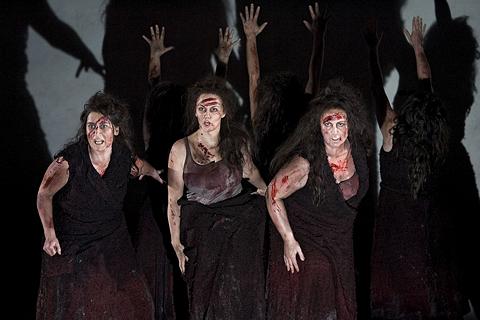|
<< -- 2 -- Robert Hugill VITAL PERFORMANCE

Siegmund sports a huge, fur-collared coat just like the one which Wotan sports when he is being Siegmund's father and, when Sieglinde comes to identify herself as Siegmund's sister, she carefully unwraps a hidden coat, just like Siegmund's. As the two run off at the end of the act, Hunding's hut disappears to reveal the ruins of the glass screen at the end of the marble hall, with its view of the sky and the void. As Wagner's music reaches a climax, the twins throw themselves off the terrace into the void.
Act 2 opens in the same hall; except now there is a large pile of books on the floor and papers gust across the stage. Brünnhilde makes her entrance descending the ladder which runs from floor to ceiling, the same ladder by which Wotan descended to Nibelheim and up which the Gods made their entrance to Valhalla. Fricka makes her entrance carrying two of Freia's golden apples; she eats hers as she leaves Wotan, her task completed satisfactorily. Wotan throws his into the hole in the floor. Brünnhilde goes down into the hole, during Wotan's monologue, but returns not with the apple but with a blue voile scarf. Quite what the significance of this is, I am not sure, but it has one very useful effect. Brünnhilde's absence means that she misses hearing Wotan's explanation about Alberich fathering a son. This is always one of the weaker points of Wagner's dramaturgy as Brünnhilde behaves in Götterdämmerung as if she knows nothing about Alberich's son; so Warner is providing a convenient explanation. Towards the end of Wotan's monologue the red rope splits and falls to the floor. When Wotan leaves Brünnhilde fiddles with it. When the twins, Siegmund and Sieglinde, are heard in the orchestra Brünnhilde attaches an end to the ram's horn chaise longue and the twins use the rope to climb up out of the void at the back of the stage, onto the terrace and back into the hall. Brünnhilde never leaves the stage, she simply watches from afar so that her appearance in the Todesverkündigung is not a surprise to us and she is clearly familiar with their relationship. At the very end of this act, the staging of Hunding's death is one of those key indicators about the director's attitude to Wotan. Sometimes, Wotan causes Hunding's death with a mere gesture, indicating the director's view of Wotan's essential divinity. Here Warner has Wotan kill Hunding with his spear; indicating an element of Wotan's humanity and his fundamental reliance on his spear to do all his will.

From left to right: Elaine McKrill (Ortlinde), Sarah Castle (Siegrune) and Irène Theorin (Helmwige) in the Covent Garden production of 'Die Walküre'. © 2005 Clive Barda
|
Warner is very keen on Wagner's debt to the German philosopher Feuerbach, and Michael Billington, who wrote two of the articles in the programme book and worked on the surtitles, has stated that Warner believes that in the Ring Warner is depicting elements of Feuerbachian philosophy, that the world of the Gods must give way to the world of men. Thus far, understandable enough in broad terms of the staging.
Continue >>
Copyright © 20 March 2005
Robert Hugill, London UK

|

